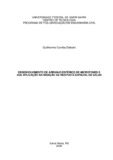Mostrar el registro sencillo del ítem
Desenvolvimento de arranjo esférico de microfones e sua aplicação na medição da resposta espacial de salas
| dc.creator | Deboni, Guilherme Corrêa | |
| dc.date.accessioned | 2021-09-16T13:04:01Z | |
| dc.date.available | 2021-09-16T13:04:01Z | |
| dc.date.issued | 2020-01-07 | |
| dc.identifier.uri | http://repositorio.ufsm.br/handle/1/22235 | |
| dc.description.abstract | This thesis aims at measuring room impulse responses with a spherical microphone array. The array consists of 32 microphones distributed throughout the surface of a rigid sphere. The text brings the methodology used to design the spherical microphone array and its application in real case scenarios. Impulsive responses were simulated for some room configurations and measured in two real rooms. The signals acquired with the spherical array were processed with conventional beamforming an energy analysis of directional impulsive responses. The results show the array’s capacity to detect the sound sources and wall reflections in both simulated and measured environments. An energy analysis shows, through a spherical grid, what are the directions of the remaining energy in the room. | eng |
| dc.language | por | por |
| dc.publisher | Universidade Federal de Santa Maria | por |
| dc.rights | Attribution-NonCommercial-NoDerivatives 4.0 International | * |
| dc.rights.uri | http://creativecommons.org/licenses/by-nc-nd/4.0/ | * |
| dc.subject | Resposta impulsiva | por |
| dc.subject | Arranjo de microfones | por |
| dc.subject | Impulse response | eng |
| dc.subject | Microphone array | eng |
| dc.subject | Beamforming | eng |
| dc.title | Desenvolvimento de arranjo esférico de microfones e sua aplicação na medição da resposta espacial de salas | por |
| dc.title.alternative | Development of spherical microphones arrayand their application in the use of the spatial rooms response | eng |
| dc.type | Dissertação | por |
| dc.description.resumo | Este trabalho tem como objetivo a medição de respostas impulsivas de salas utilizando um arranjo esférico de microfones. O arranjo é composto por 32 microfones distribuídos ao longo da superfície de uma esfera rígida. O texto traz a metodologia utilizada para a confecção da esfera de microfone. As respostas impulsivas foram simuladas para algumas configurações de salas e medidas em dois ambientes. O processamento dos sinais foi realizado através da técnica de beamforming e análise energética das respostas impulsivas direcionais. Os resultados mostram a capacidade do arranjo em detectar as fontes sonoras e as reflexões que ocorrem nos ambientes medidos e simulados. A análise energética mostra através de um grid esférico quais as direções de chegada da energ | por |
| dc.contributor.advisor1 | Carneiro, Eric Brandão | |
| dc.contributor.advisor1Lattes | http://lattes.cnpq.br/2876372207029481 | por |
| dc.contributor.advisor-co1 | Fonseca, William D'Andrea | |
| dc.contributor.advisor-co1Lattes | http://lattes.cnpq.br/1677987461176747 | por |
| dc.contributor.referee1 | Masiero, Bruno Sanches | |
| dc.contributor.referee2 | Gomes, Marcio Henrique de Avelar | |
| dc.creator.Lattes | http://lattes.cnpq.br/7425298232154767 | por |
| dc.publisher.country | Brasil | por |
| dc.publisher.department | Engenharia Civil | por |
| dc.publisher.initials | UFSM | por |
| dc.publisher.program | Programa de Pós-Graduação em Engenharia Civil | por |
| dc.subject.cnpq | CNPQ::ENGENHARIAS::ENGENHARIA CIVIL | por |
| dc.publisher.unidade | Centro de Tecnologia | por |
Ficheros en el ítem
Este ítem aparece en la(s) siguiente(s) colección(ones)
-
Programa de Pós-Graduação em Engenharia Civil [480]
Coleção de dissertações do Programa de Pós-Graduação em Engenharia Civil



